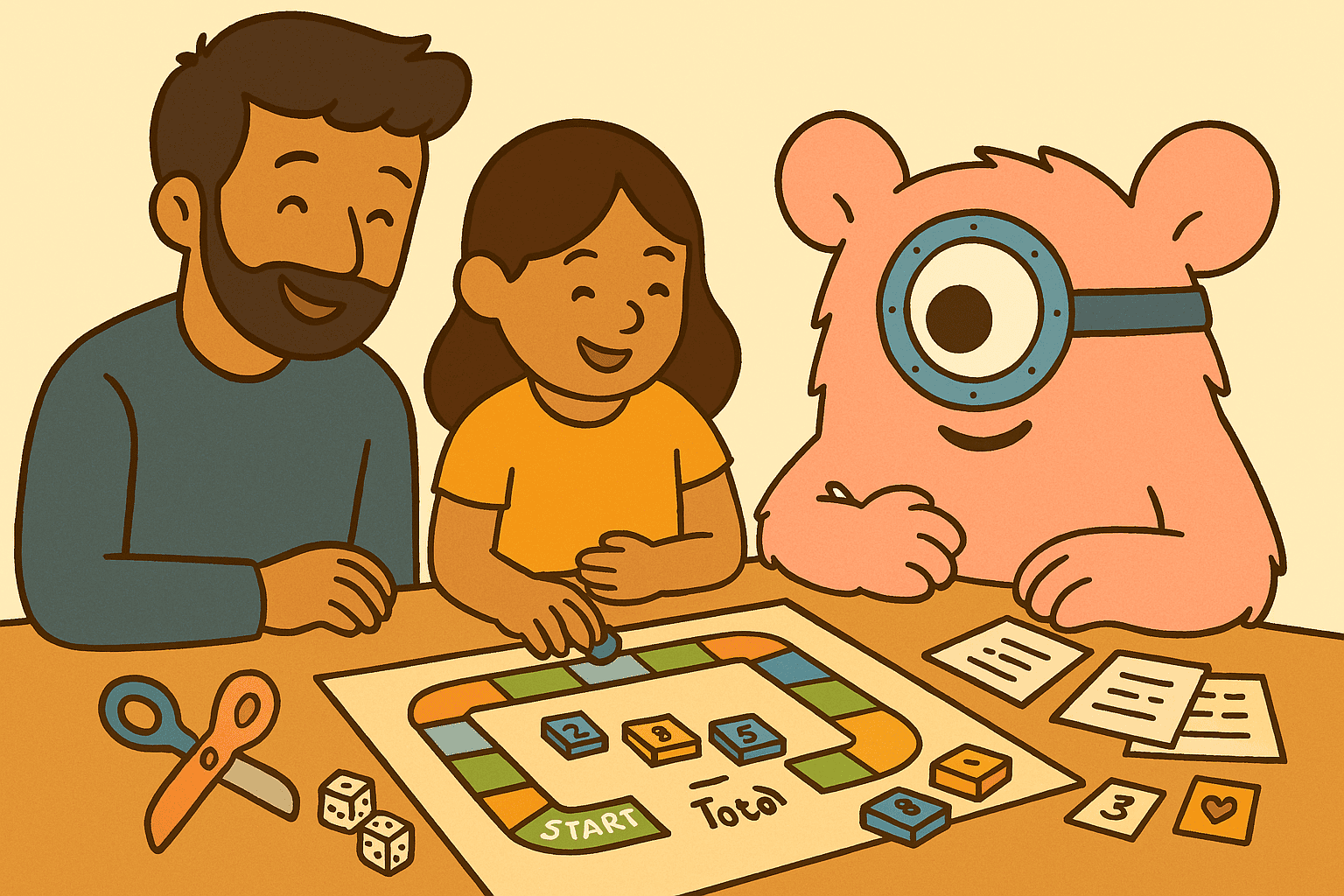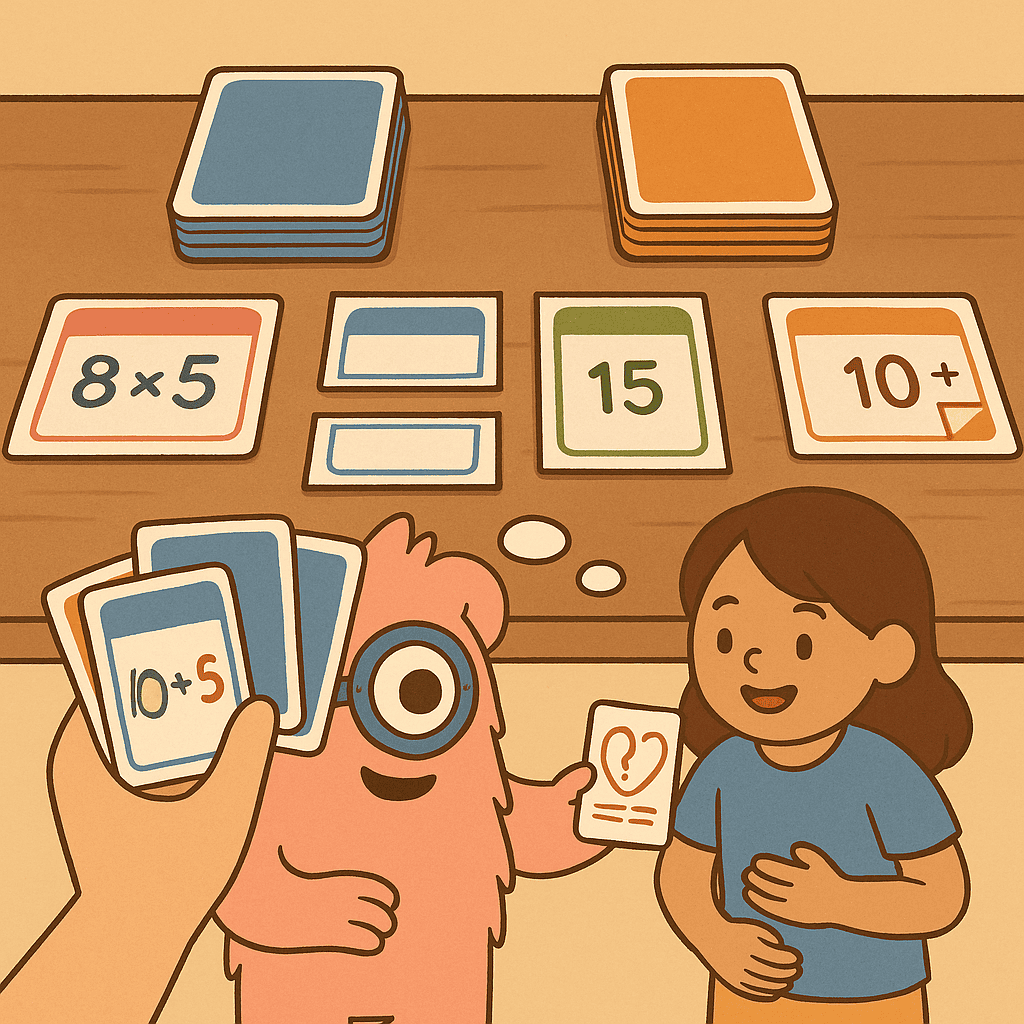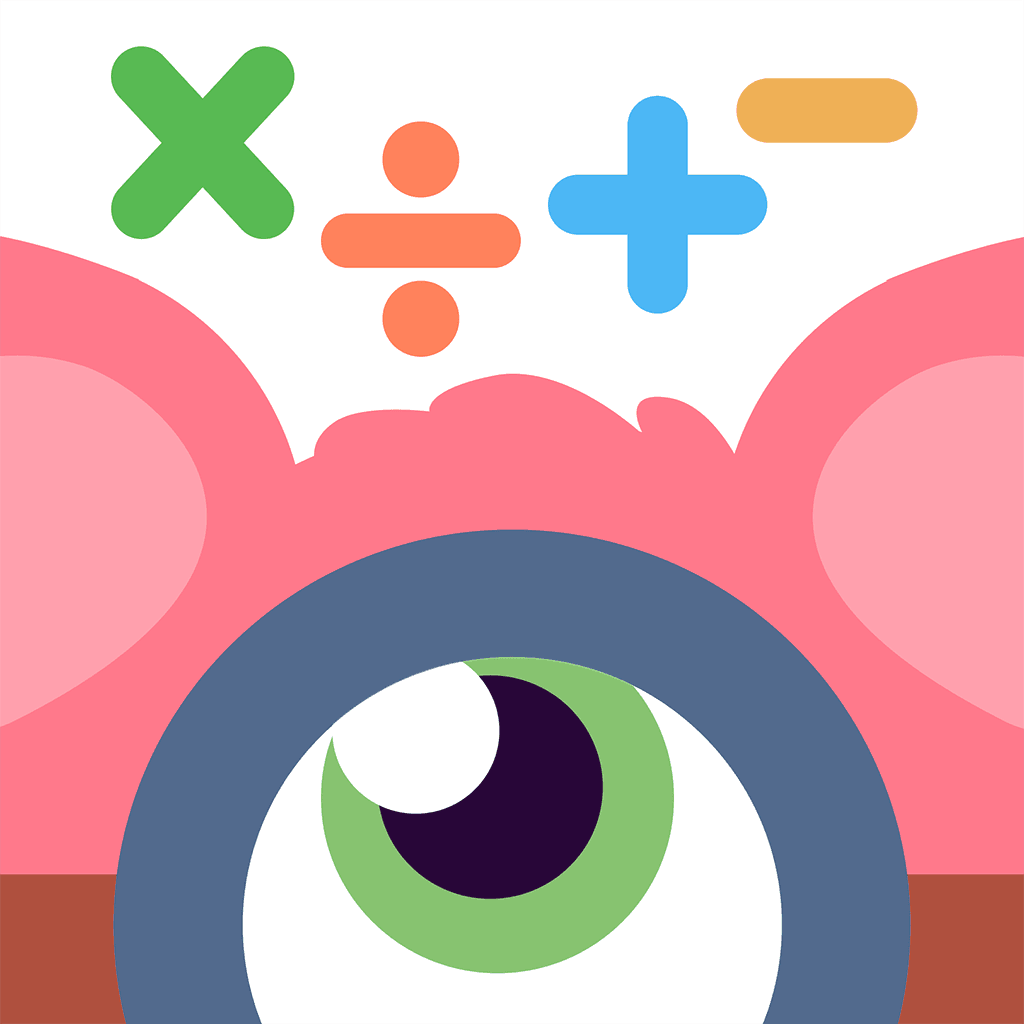Co-Play Learning: How Parents Can Gamify Math at Home.
TL;DR: Imagine your living room becoming a calm “math play zone” where you and your child take turns as teammates, swapping roles, cheering small wins, and building math-fact fluency through short, joyful games. Co-play helps dyscalculia learners because it reduces language load, uses visual/tactile supports, and shifts math from pressure to play without overstimulation.

What Is Co-Play Learning (and Why It Works So Well for Math)?
Co-play learning means parent and child learn together as partners: solving problems, asking questions out loud, and sharing control in short, predictable sessions. In math, that looks like joint attention on a game board or set of counters, quick back-and-forth prompts, and immediate, friendly feedback. This “learning together” naturally boosts the home numeracy environment. Shared attention and joint engagement deepen motivation and connection.
With math facts (like addition, subtraction, multiplication), co-play allows the parent to scaffold and cue rather than simply test, turning facts into patterns and fun rather than rote drills.
Because co-play embeds math into everyday activities, learners see math as meaningful rather than isolated.
Research into “home numeracy environments” shows that parent-child math talk and shared activities correlate with stronger arithmetic outcomes. For example, a study found that during numeracy-related games, parents used more number-talk, counting, estimation when the format was non-digital (board game) rather than purely electronic.
During number board-game play, caregivers tend to produce richer math talk counting, estimation, spatial language, than in many digital settings, a pattern observed across traditional versus digital board-game formats.That conversational scaffolding is gold for mastering basic facts.
Why Dyscalculia Learners Benefit Most from Co-Play
Dyscalculia is a specific numerical-learning difference where children struggle with number magnitude, arithmetic reasoning, symbol-quantity links and applying math in daily life, despite typical intelligence and schooling.
Here’s why co-play is particularly helpful for dyscalculia learners:
- Reduced anxiety and increased support: Learners with dyscalculia often face math anxiety, reluctance, and negative experiences. A co-play environment that feels safe and engaging reduces that emotional barrier
- Multiple entry-points: Co-play allows quantitative, visual, tactile, game-based strategies rather than only symbol-drill; research shows game-based, multi-sensory interventions improve outcomes for dyscalculia learners.
- Immediate feedback and scaffolding: In parent-child co-play you can scaffold (hint, encourage, adjust) in real-time, helping children link concrete and symbolic understanding.
- Meaning-making beyond school: Many dyscalculia learners struggle when math facts are disconnected from meaningful context. Co-play embeds math facts into real life and game-routines, improving retention and relevance.
Thus, co-play isn’t just “fun”, it aligns with the specific needs of dyscalculia: scaffolded, multi-sensory, meaningful, and low-pressure.
The Science Behind Gamified Family Learning
Gamification refers to using game elements (points, levels, feedback, challenges) in non-game contexts (like learning) to increase motivation and engagement. Research shows that game-elements like “objectives, levels, progress, choice” contribute strongly to learning engagement.
From this we derive key design cues: use clear objectives, allow progress/levels, include choice, provide immediate feedback, embed social/co-play elements, and favor formats that encourage discussion and scaffolding rather than passive screen time.
Balancing Fun and Focus: Avoiding Overstimulation
When using gamification at home, especially for children with learning differences, one risk is overstimulation, too many flashy elements, too much speed, too many rewards, which can backfire. Here’s how families can balance fun and focus:
- Keep sessions short and structured: For math facts, 5-10 minutes of focused co-play is often enough; longer than that may lead to fatigue or distraction.
- Clear, simple rules: Minimize clutter. A game with too many rules or flashy distractions can overwhelm a dyscalculia learner whose cognitive load is already high.
- Allow downtime and reflection: After gameplay, take a 30-second pause to talk about what happened. “What did you notice?” “What was tricky?” This strengthens metacognitive awareness.
- Limit reward-fatigue: If every correct answer triggers a big “celebration”, the novelty wears off and focus shifts from the math fact to the reward. Use moderate rewards and emphasize progress.
- Cue emotional check-ins: Ask: “Are you feeling good about this?” “Do you want to continue or take a break?” This helps avoid frustration or shutdown.
- Set a calm environment: Soft lighting, minimal background noise, and a predictable routine signal to the learner that “this is math-play time” rather than test time.
By balancing stimulation with structure, you build a sustainable environment that supports learners with dyscalculia rather than overwhelming them.
Simple rules, fewer, calmer stimuli help sustain attention for learners with high working-memory demands.
Reflective cool-down like one minute of “What got easier today?” builds metacognition.
If you would like to dive deeper into the topic read "Metacognitive math routines".
Simple Ways to Gamify Everyday Math (Without Screens)
Here are practical, low-tech ways parents can turn everyday moments into co-play math-fact opportunities by increasing repetition in low-stress format, and encouraging parent–child interaction.

Card-deck “Battle”
Use a standard deck (or a custom one) of math facts (e.g., multiplication facts on cards). Each player flips, solves, winner keeps the card.
Level up: collect 5 cards → “upgrade” to next fact family.
- Why this helps: Builds retrieval fluency through repetition with immediate feedback, the learner gets multiple, fast-paced exposures to math facts in low-stakes turns.
- Alternating turns allow modeling: the parent’s verbalization (“6×7… that’s 42”) demonstrates efficient strategies like grouping or doubling, which the child imitates. In dyscalculia, where memory for number combinations is fragile, repeated recall in a game setting supports automaticity and confidence without anxiety.
Dice Race
Roll two dice, add or multiply and get the result. First to answer gets 1 point. First to the “finish line” (score 50) wins.
Variation: subtract dice for quick reverse-fact practice.
- Why it helps:The dice introduce subitizing (recognizing small quantities instantly) and probability intuition essential foundations for number sense. Rolling and adding/multiplying links concrete quantity perception (dots) with symbolic operations, bridging the abstract gap that dyscalculia learners often face
- The race mechanic provides a clear goal state (reach 50 first), sustaining engagement and allowing self-paced fluency practice.Alternating addition/subtraction/multiplication trains flexible thinking about number relationships key for conceptual understanding, not just recall.
- Supports findings that game-based repetition enhances arithmetic fluency and working memory integration in children with math difficulties.
Sticker Ladder
For each fact mastered (with you), learner gets a sticker and advances one rung on a ladder. At top, choose a reward (e.g., pick dinner menu).
- Why it helps: Converts abstract progress (“I know more facts”) into visible mastery tracking, ideal for students with executive-function challenges.
- Each sticker acts as positive reinforcement tied to effort and completion, not just correctness, nurturing growth mindset.The ladder metaphor gives a structured sequence.
- Learners see a clear path toward mastery, which supports the need for predictability common among neurodivergent learners. Helps parents focus on process praise (“You practiced steadily”) rather than performance praise (“You’re smart”).
Hop‐scotch Facts
Draw hop-scotch grid with sums or products in each square. Learner hops to the “answer” square after you call a question.
- Why it helps: Integrates embodied cognition: movement paired with cognition strengthens memory encoding, particularly for children with attentional differences.
- Physical hopping activates the vestibular and motor systems, improving focus and engagement while rehearsing math facts.
- Calling questions aloud introduces auditory processing, engaging multiple modalities (visual, kinesthetic, auditory).
Puzzle Pieces
Create a jigsaw where each piece has a math fact on the back; solving the fact correctly allows you to place the piece. Finish puzzle = bonus round.
- Why it helps: Links problem solving with visual completion, every solved fact literally helps “build the picture,” reinforcing a sense of agency.
- Jigsaw structure leverages pattern recognition and spatial reasoning, areas often relatively strong in dyscalculia learners.
- Encourages persistence and planning (“Which piece next?”), strengthening executive functioning alongside math fluency. Completing the puzzle creates a dopamine-driven success loop, reinforcing perseverance. Multi-sensory (touch, sight, logic) engagement aids memory integration of number facts beyond rote recall.
Treasure Map
Parent draws a simple map with 10 “stepping stones”. Each stone corresponds to a math fact. Learner solves facts to move from stone to stone until they reach the treasure.
- Why it helps: Frames math practice as narrative progression: each solved fact advances the story, transforming repetition into adventure.
- Supports episodic memory linking, the learner recalls facts via contextual cues (“I needed 7×8 to reach the treasure stone”).The visual-spatial layout (stepping stones, path) creates a mental map of progress, engaging spatial memory circuits.
- Encourages planning and sequencing, areas often co-affected in dyscalculia. Aligns with schema-based instruction principles: organizing facts into coherent journeys improves transfer and retention
Want more playful ideas? See our guide to family-friendly board games that help dyscalculia children love math.
Creating a Calm “Math Play Zone” at Home
One of the keys to making co-play effective for dyscalculia learners is establishing a predictable, calm environment where math becomes play, not test. Here’s how to set up a “math play zone”:
- Dedicated space: A small table, comfortable chairs, good lighting, minimal distractions, no TV on, no background phone pings.
- Visual routine: A visible timer (analogue or digital) set to 5–10 minutes; a “game board” area with pieces, cards, tokens laid out.
- Consistent timing: Choose a regular time (e.g., post-snack or pre-bed snack), so the brain anticipates “math play” as part of routine.
- Materials ready: Cards, dice, tokens, chart of progress; you don’t want to spend time hunting supplies every session.
- Calming cues: Soft lighting, low background noise, perhaps a ritual: “Let’s pick our game, set the timer, and begin”.
- Signal transitions: Use a short “cool-down” (e.g., stretch or high-five) after the session and a “celebration notice” (e.g., “Great job – our champion token goes here”).
- Parent role clarity: Decide your role (coach/teammate) not just judge/referee. Your job is to scaffold, support, encourage & not evaluate.
This environment cues the brain: “Math time = safe, fun, parent-involved” rather than “Math time = test and stress”.
Looking for gentle digital support to compliment co-play? Do give these four apps a try. Monster Math(builds concrete-to-abstract understanding), ST Math (supplemental visual practice), DragonBox (concept-based math play) and Toy Theatre (interactive math manipulatives and mini-games that make visual exploration fun and concrete).
Measuring Progress Without Pressure
Because math fact fluency is a matter of repetition, accuracy and speed, tracking progress is important, but it must be done without triggering anxiety or comparison with “others”. Here’s how to keep measurement gentle and effective:
- Personal bests: Record the child’s own previous best time/score and aim to beat that, rather than comparing to siblings or external norms.
- Token milestones: Use tokens/stickers for each mastered fact family. When the ladder is full, the next level begins. The emphasis is “progress” not “perfection”.
- Error logs: Keep a simple log of “facts needing repeat practice” (maybe 3–5 facts each week) and revisit them in low-key games.
- Reflective talk: At the end of game-time: “Which fact surprised you?” “Which felt easy now?” This builds metacognition.
- Visual progress charts: A quiet wall chart with ticks or small icons marking each successful session. No grades, just “we did it”.
- Parent observation notes: After each session, note: “Was engagement high?” “Did the learner ask for a break?” “Did we move too fast/slow?” Use these to adjust.
- Celebrate effort and strategy: Praise the process (“You tried the tricky facts again!”) rather than only the result. This builds confidence in dyscalculia learners.
By tracking progress this way, you reinforce growth mindset, avoid pressure, and keep the focus on shared adventure rather than performance.
Bringing It All Together: Making Math a Shared Adventure
To summarize, here’s how you as a parent can weave co-play, dyscalculia-friendly strategies, gamification and calm environment into a consistent home practice:
- Set up: Choose a regular time (e.g., post-snack), clear the “math play zone”, gather materials.
- Warm-up: 1–2 minutes of “number talk”, weave math into your child's daily activities: “How many apples did we buy? What if we bought 3 more?”
- Game session (5-10 mins): Choose a game from above (board/card/dice). Parent and child co-play, you alternate asking/answering, you encourage, you scaffold when needed.
- Reflection (1-2 mins): Ask “Which facts got easier?” “Which ones we’ll revisit next time?” Mark success on your chart.
- Cool-down: High-five, token for the child, “Champion ladder” advance, perhaps a low-key reward (they pick dinner side-dish next time).
- Progress check weekly: Review the sticker ladder or personal-best chart. Celebrate this week’s wins. Adjust next week’s target or game format if motivation dipped.
By making the routine predictable, fun, shared, low-pressure and scaffolded, you turn math facts from chore to family adventure.
FAQs
How long should co-play sessions be?
Five to ten minutes of focused, friendly play is plenty; beyond 15 minutes, fatigue and distraction rise for many learners with high working-memory demands.
Is speed the goal?
No. We prioritize accuracy, strategy, and confidence. Speed emerges gradually as facts stabilize.
What if my child resists?
Offer choice of game, keep sessions short, and let your child quiz you sometimes. Control and humor reduce anxiety.
Peer reviewed References.
- PMC2913999 – Developmental Dyscalculia: Interventions and Neural Basis
- ScienceDirect – Cognitive and Neural Mechanisms of Mathematical Learning
- PMC11201520 – Developmental Dyscalculia in relation to individual diffirences in mathematical abilities.
- Educational Robotics and Game-Based Interventions for Overcoming Dyscalculia: A Pilot Study
- SpringerOpen – Serious Learning Games: Cognitive and Motivational Impacts
- Effects of Game-Based Learning Supports on Students' Math Performance and Perceived Game Flow


Comments
Your comment has been submitted successfully!